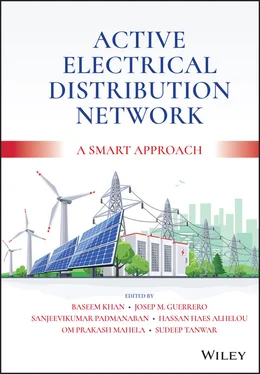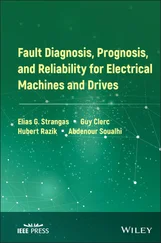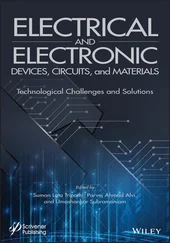Active Electrical Distribution Network
Здесь есть возможность читать онлайн «Active Electrical Distribution Network» — ознакомительный отрывок электронной книги совершенно бесплатно, а после прочтения отрывка купить полную версию. В некоторых случаях можно слушать аудио, скачать через торрент в формате fb2 и присутствует краткое содержание. Жанр: unrecognised, на английском языке. Описание произведения, (предисловие) а так же отзывы посетителей доступны на портале библиотеки ЛибКат.
- Название:Active Electrical Distribution Network
- Автор:
- Жанр:
- Год:неизвестен
- ISBN:нет данных
- Рейтинг книги:5 / 5. Голосов: 1
-
Избранное:Добавить в избранное
- Отзывы:
-
Ваша оценка:
- 100
- 1
- 2
- 3
- 4
- 5
Active Electrical Distribution Network: краткое содержание, описание и аннотация
Предлагаем к чтению аннотацию, описание, краткое содержание или предисловие (зависит от того, что написал сам автор книги «Active Electrical Distribution Network»). Если вы не нашли необходимую информацию о книге — напишите в комментариях, мы постараемся отыскать её.
Discover the major issues, solutions, techniques, and applications of active electrical distribution networks with this edited resource Active Electrical Distribution Network: A Smart Approach
Active Electrical Distribution Network: A Smart Approach
Active Electrical Distribution Network — читать онлайн ознакомительный отрывок
Ниже представлен текст книги, разбитый по страницам. Система сохранения места последней прочитанной страницы, позволяет с удобством читать онлайн бесплатно книгу «Active Electrical Distribution Network», без необходимости каждый раз заново искать на чём Вы остановились. Поставьте закладку, и сможете в любой момент перейти на страницу, на которой закончили чтение.
Интервал:
Закладка:
3.3.1.4 Reverse Power Flow Due to Inappropriate Allocation of Distributed Generators
Distributed generation (DG) is considered as an essential part in future distribution power systems. Grids are eventually being converted into smart grids with annexation of advanced and improved, technologically sound distributed generation (DG) sets, along with their advanced control systems, adaptive structures, effective sensors, information and communication technologies [18]. The DG insertion has changed the complete mode of operation of the distribution systems. The traditional one directional flow of power in the lines has changed to a two-way mode, which leads to an urgent need to redesign the protection systems. In smart grids the complicacy of the transformed structures and technologies of the power system is monitored and meticulously controlled by sensors, smart meters, digital controllers, and adaptive technologies [19].
3.3.1.5 Reactive Power Management
The renewable generation is connected to the distribution network at the low-voltage up to the high-voltage (HV) level. The insertion of this power can cause an objectionable voltage rise. Reactive power is also required to sustain and transfer this power in the transmission network. If distribution network operators (DNOs) regulate the reactive power locally, the distribution generators can contribute to reduce the many technical problems of the system. Reactive power production as well as its consumption, as required in the system by generators, urge the network operators to control operation of systems like voltages, stability, load angle, frequency, and power flow throughout the contributing system. Reactive power is one of the most important factors encountered for ensuring the smooth flow of the apparent power in the power lines. Generators are considered to be the prime source for reactive power and need to comply with the reactive power demand of the system and load. Due to many undesirable factors and inappropriate functioning of a few components or parts of the system, there may be evidence of an unrealistic flow of excessive reactive power in the transmission periphery, which may cause voltage instability and uneconomic network performance. Thus the reactive power control in a minor as well as a major power network is important, particularly for a steady load. However, the control of reactive power is difficult for network operators in large systems, where the system consists of long-length power lines and highly variable load because of widely and frequently varying meteorological conditions [20].
3.3.1.6 Voltage Profile Management
Increasing deployment of distributed generation units in the distribution network brings new challenges, such as voltage fluctuations, power quality hampering, and reverse power flows. The sudden changes in electric power generation from the DGs due to climate conditions or their internal glitch might cause high-voltage variations. In such critical scenarios both low load requirements and high power contributions from renewable sources possibly results in voltage, power, and load angle limit violations. To ride through this state of a highly approved approach is the disconnection of such units or curtailment of power generation, which may lead to several disadvantages, such as a sudden reactive power imbalance, harmonic distortion, voltage instability, and malfunction of protection devices [21]. Thus the DG insertion has proved to be a boon accompanied with many technical challenges that are definitely required to be analyzed in order to enjoy all the benefits of DG insertion in the distribution networks.
3.3.1.7 Network Restructuring
Due to the low-voltage–high-current operating scenarios of the distribution system, I 2R losses are the major concern of DNOs and need to be taken care off to improve the performance of the system. Network restructuring is one of the methods to deal with this problem, which is generally used in low-voltage distribution systems. It is a very effective and conclusive method to save the electrical energy. Distribution systems consist of a large number of interconnected radial and mesh networks. The network configuration and structures of distribution systems may be varied through switching operations to reallocate loads in the feeders with exhaustive planning. This can be executed through two types of switches, which are often used in primary as well as secondary distribution systems:
Sectionalizing switches (normally closed switches) or
Tie switches (normally open switches)
These types of switches are particularly structured for protection and configuration supervision of complicated distribution systems. Network reconfiguration is the commonly used process of altering the distribution systems topology by changing the open/closed position of the switches. Reconfiguration is primarily applied for:
1 Service restoration during faulty conditions
2 Load balancing forrelease of overburdened power lines andto improve the overall voltage profile
3 Planning the line outages for maintenance conditions and
4 Loss reduction
Loss minimization executed by the switching operation is found to be the elementary control action in network restructuring. The prime activity is the closing of the switches in an opened branch and opening the switch in a closed one by maintaining the network state radial. However, due to the possibility of several candidates switching combinations in the system at the same time, it is a complex combinatorial problem. This distinct feature of the availability of numerous switch combinations makes it a discrete optimization.
Recurring changes in formation can cause outages or transient problems. However, network restructuring has proved to be a complex combinatorial decision-making execution for contributors to trace, which generally requires extensive numerical designs and scheming, and affects the management of the control strategies of protective devices. In feeder reconfiguration, it is usually assumed that the protecting elements are precisely harmonized and correlate when the feeder configurations are altered by acute switch operations, which are achieved through essential protective device planning and coordination, usually carried out for secure configuration [22].
3.3.1.8 Impacts of Distributed Generator Insertion
Continuously growing energy requirements resulting due to industrialization, environmental concerns with diminishing fossil fuel resources, network congestion as a result of overburdened lines, and declining technical performance are the key motivating factors for the day-to-day increase in integration of both renewable as well as non-renewable distributed generation (DG) units and transition of the prevailing power systems into restructured and advanced systems. Improving the technological and economic outcomes as a result of DG allocation is the biggest challenge for distribution network operators (DNOs) for both types of distributed generators. Distribution system engineers showed strong interest in these tiny energy sources due to their technical, economic, and environmental enticements. Its impending assistance includes improved system reliability, greenhouse gas emissions, and energy loss reductions [23]. However, the increased rate of DG deployment provides a prime challenge to distribution network operators because traditional distribution networks are not designed to connect power generation facilities on their doorsteps. With the integration of DGs in these passive networks, wide ranges of alternations and sometimes parameter violations result in variability and uncertainty in the operation of renewable energy resources (RERs). It has been found that renewable DGs reveal many associated power quality (PQ), characteristics hampering, and performance violation challenges to the operators. Power quality is one of the most significant characteristics of renewable DG systems because today’s loads are excessively sensitive to PQ disturbances. Therefore, the need for innovative power quality improvement techniques becomes a foreseeable feature of the restructured power system [24].
Читать дальшеИнтервал:
Закладка:
Похожие книги на «Active Electrical Distribution Network»
Представляем Вашему вниманию похожие книги на «Active Electrical Distribution Network» списком для выбора. Мы отобрали схожую по названию и смыслу литературу в надежде предоставить читателям больше вариантов отыскать новые, интересные, ещё непрочитанные произведения.
Обсуждение, отзывы о книге «Active Electrical Distribution Network» и просто собственные мнения читателей. Оставьте ваши комментарии, напишите, что Вы думаете о произведении, его смысле или главных героях. Укажите что конкретно понравилось, а что нет, и почему Вы так считаете.











